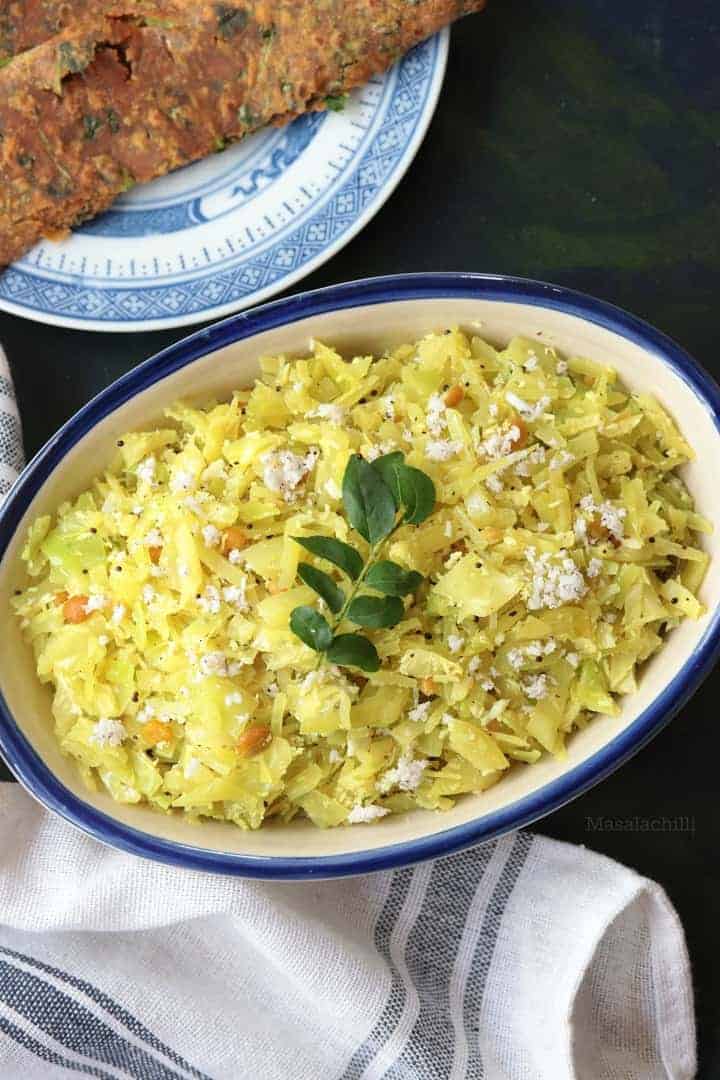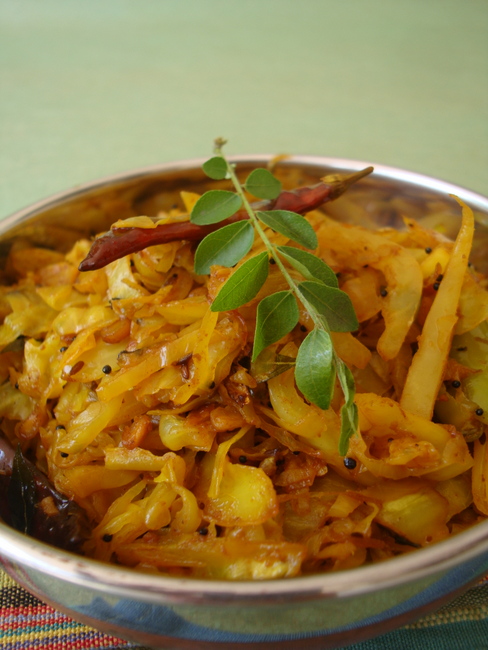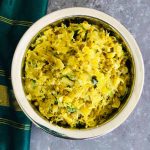Cabbage Palya is a classic South Indian stir-fry dish that primarily features shredded cabbage cooked with an array of spices and seasonings. It is a simple, yet flavorful vegetarian side dish often prepared in the states of Karnataka and Kerala, and possibly in other South Indian regions as well.
The dish usually starts with tempering mustard seeds in oil, to which urad dal (split black gram), chana dal (split chickpeas), curry leaves, and asafoetida are added for aromatic depth. Shredded cabbage, along with green chilies, salt, and sometimes a pinch of turmeric powder, is then sautéed in this tempered mixture until the cabbage becomes tender yet retains some of its crunch. Some variations might include the addition of grated coconut, red chili powder, or other vegetables like carrots or peas to enhance the taste and nutritional value.
Cabbage Palya Recipe


Cabbage Palya
Equipment
- 1 large skillet
- 1 blender
Ingredients
- 2 tablespoons corn oil
- 11/2 teaspoons mustard seeds
- 11/2 teaspoons husked whole black lentils
- 11/2 teaspoons Bengal gram
- 4 green chiles finely chopped
- 2 curry leaf sprigs
- 1 green cabbage shredded (about 10 cups)
- 1 tablespoon salt
- 1/2 teaspoon ground turmeric optional
- 1 cup shredded fresh coconut or frozen, thawed to room temperature
- 1 2-inch piece fresh ginger, peeled and roughly chopped
- 2 tablespoons finely chopped fresh cilantro
Instructions
- In a large skillet over medium heat, heat the oil.
- Add the mustard seeds, black lentils, and Bengal gram. Cook until the mustard seeds begin to sputter, about 1 minute.
- Add the green chiles and curry leaves and cook for 30 seconds.
- Add the cabbage, salt, and turmeric (if using), and mix thoroughly. Cover the skillet and cook for 12 minutes. Remove the lid and increase the heat to medium-high. Cook for 10 to 12 minutes more until all the moisture has evaporated.
- While the cabbage cooks, in a blender, combine the coconut and ginger and grind until coarse. Add this to the cabbage once the moisture is evaporated and mix well. Cook for 1 minute. Turn off the heat and stir in the cilantro.
Notes
carrots, and beets.
Cooking Tips about Cabbage Palya

- Choose Fresh Cabbage: Select a cabbage that is firm and heavy for its size with crisp, tightly packed leaves.
- Shred Thinly: Thinly shred the cabbage so that it will cook evenly and quickly, retaining a bit of crunch in the final dish.
- Tempering Is Key: Start your palya with a good tempering (tadka) of mustard seeds, curry leaves, asafoetida (hing), and urad dal (optional). This adds a nice aroma and flavor base to the dish.
- Saute Onions to Golden Brown: Sauté onions until they are golden brown before adding the cabbage, as this imparts a sweet flavor to the palya.
- Add Spices Sparingly: Since cabbage has a delicate flavor, go easy on the spices. A little turmeric powder, salt, and green chilies are usually sufficient.
- Stir Fry on Medium Heat: Cook the shredded cabbage on medium heat. This allows for even cooking without letting the cabbage become too soggy.
- Do Not Overcook: It’s important not to overcook the cabbage as it should retain some of its natural texture and not become mushy.
- Cover to Steam Cook: If the cabbage isn’t cooking through, sprinkle a little water and cover the pan for a while. However, remember that cabbage releases its own water, so use this technique sparingly.
- Finish with Grated Coconut: Towards the end of the cooking process, add freshly grated coconut for an authentic South Indian touch.
- Garnish and Serve: Garnish with freshly chopped coriander leaves if desired and serve hot with chapatis or as a side dish with rice and sambar or rasam.
- Avoid Browning the Cabbage: Keep an eye out to make sure that the cabbage does not start to brown unless that is the effect you are intentionally going for, as it may change the flavor profile of the dish.
Serving suggestions about Cabbage Palya

- With South Indian Staples: It pairs excellently with traditional South Indian staples like steamed rice and rasam or sambar. Enjoy it as part of a thali with other accompaniments.
- As a Filling for Dosas: Use the Palya as a filling for dosas, making a nutritious and tasty variation of the masala dosa.
- With Flatbreads: Serve alongside flatbreads such as chapatis or rotis. The softness of the bread complements the crunchiness of the palya.
- As An Accompaniment: Use it as an accompaniment to main courses like grilled or roasted meats, where its freshness can balance out the richness of the meat.
- In Sandwiches or Wraps: Mix the palya with some fresh greens and your choice of proteins to make a hearty sandwich or wrap filling.
- Alongside Pulao or Biryani: A small serving of Cabbage Palya can refresh the palate when served with more heavily spiced rice preparations like pulao or biryani.
- Part of a Salad Plate: Combine the Palya with other salads to offer a spread with varying textures and tastes.
- As a Side to Yogurt Dishes: It goes well with yogurt-based dishes such as raita or buttermilk, providing a contrast in temperature and creaminess.
Top 5 FAQs about Cabbage Palya

- What are the main ingredients for making Cabbage Palya? The main ingredients for making Cabbage Palya include shredded cabbage, mustard seeds, urad dal (split black gram), chana dal (split chickpeas), curry leaves, green chilies, asafoetida (hing), turmeric powder, salt, and sometimes grated coconut for garnishing.
- How can I prevent Cabbage Palya from becoming soggy? To prevent the palya from becoming soggy, avoid overcooking the cabbage. Cook it on medium heat until just tender but still crunchy. Also, remember that cabbage releases water while cooking, so adding extra water isn’t usually necessary. Cover the pan only if absolutely needed, and do it sparingly.
- Can I add other vegetables to the Palya? Yes, you can add other vegetables like carrots, peas, or bell peppers to enhance the nutritional value and add color to the dish. Just make sure to adjust the cooking time accordingly, adding harder vegetables earlier and softer ones later in the cooking process.
- Is Cabbage Palya suitable for a vegan diet? Absolutely, Cabbage Palya is naturally vegan. It is a stir-fried dish made with vegetables and spices without any animal products. It’s a healthy addition to any plant-based meal.
- What do I do if my Palya is too dry or lacks flavor? If the palya seems too dry, you can sprinkle a little water to help it cook, being careful not to make it mushy. For more flavor, check the seasoning and adjust it to your taste by adding salt or more spices. Finishing the dish with fresh grated coconut and a squeeze of lemon juice can also enhance the flavors.
Cabbage Palya is a delightful South Indian dish that stands out for its simple yet aromatic flavors, striking a perfect balance between the tender crunch of cabbage and the robustness of tempered spices. With its light and healthful properties, it is well-suited for both everyday meals and special occasions. The charms of this dish lie in not just its taste but also its versatility – it can be enjoyed with a variety of accompaniments, from rice and flatbreads to dosas and salads.

Leave a Reply